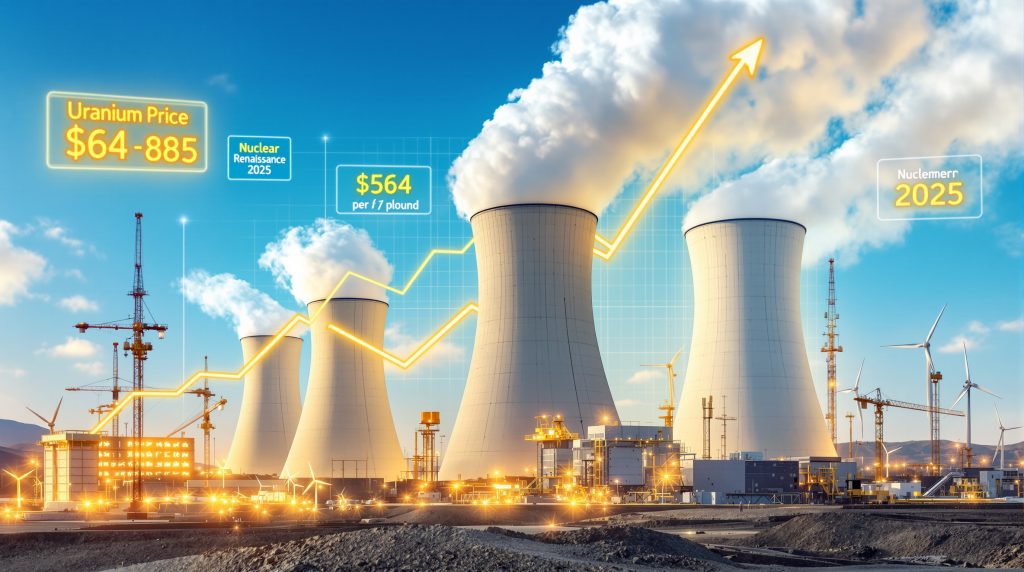The Rising Tide: Why Uranium Prices Are Surging in 2025
Global Nuclear Renaissance
The resurgence of nuclear power globally has become a primary catalyst for uranium's price appreciation. Countries worldwide are increasingly recognizing nuclear energy as an essential component for meeting ambitious climate goals while ensuring energy security. This fundamental shift represents a dramatic reversal from the cautious post-Fukushima sentiment that dominated the 2010s.
Nations from China and India to France and the United Kingdom are expanding their nuclear fleets, driven by the realization that achieving net-zero carbon targets requires reliable, dispatchable baseload power that renewable sources alone cannot provide. According to the International Atomic Energy Agency, nuclear capacity additions have reached their highest level in over three decades.
Supply-Demand Imbalance Intensifies
The uranium market has entered a structural deficit after years of underinvestment in mining capacity. This supply crunch coincides with rapidly growing demand, creating perfect conditions for sustained price appreciation. According to data from the American Nuclear Society, uranium reached $82.63 per pound by September 2025, marking the year's highest level.
This price surge represents a dramatic 28.7% increase from the March 2025 low of $64.23 per pound. The market supply volatility supporting this rally appears robust, with primary production still lagging behind consumption despite the price incentives.
Mining companies have been slow to restart mothballed operations due to technical challenges, regulatory hurdles, and the substantial capital requirements needed to bring idle capacity back online. Even Kazakhstan, the world's largest uranium producer, has struggled to significantly increase output despite favorable price conditions.
Long-Term Contracting Accelerates
Utilities worldwide have dramatically increased their contracting activity throughout 2025, seeking to secure future uranium supplies amid growing concerns about availability. This forward-buying behavior has placed additional pressure on already tight inventories.
The nuclear fuel buying cycle typically operates on multi-year contracts, with utilities securing supplies 3-5 years in advance. The current wave of contracting represents utilities' recognition that the supply deficit could persist longer than initially anticipated, prompting them to lock in supplies at current prices rather than risk future shortages or higher costs.
Industry analysts report that long-term contract volumes in 2025 are tracking at nearly double the average annual rate seen during the 2018-2022 period, reflecting widespread concern about future uranium availability.
How Have Uranium Prices Performed in 2025?
Quarterly Price Progression
The uranium market has demonstrated remarkable strength throughout 2025, with prices climbing steadily across all quarters:
| Period | Spot Price (USD/lb) | Change | Market Dynamics |
|---|---|---|---|
| Q1 2025 (March low) | $64.23 | Baseline | Seasonal weakness, temporary production increases |
| Q2 2025 (June) | $78.50 | +22.2% | Utility buying season, supply disruptions |
| Q3 2025 (September) | $82.63 | +5.3% | Increased reactor construction announcements, inventory drawdowns |
| Q4 2025 (Projected) | $85-95 | +3-15% | Anticipated continued supply tightness, year-end contracting |
This consistent upward trajectory differs significantly from previous uranium cycles, which were often characterized by sharp rallies followed by equally dramatic corrections. The current market appears to be experiencing a more sustainable, fundamentally-driven appreciation.
Price Volatility Factors
Several key events have triggered notable price movements throughout 2025:
-
Production challenges at key mines: Canada's McArthur River operation, one of the world's highest-grade uranium mines, experienced unexpected technical difficulties in Q2, temporarily reducing output by approximately 15%.
-
Geopolitical tensions affecting uranium-producing regions: Political instability in Niger, which accounts for approximately 5% of global uranium production, raised concerns about supply continuity from the region.
-
Unexpected reactor restarts in Japan and Europe: Japan's accelerated restart program brought three additional reactors back online in 2025, exceeding initial projections and signaling stronger-than-anticipated demand.
-
Strategic purchasing by newly formed uranium investment funds: Several uranium-focused investment vehicles have accumulated substantial physical inventories, effectively removing material from an already tight market.
The combination of these factors has created a market environment characterized by tightening supplies, expanding demand, and heightened investor interest—all contributing to uranium's strong price performance in 2025.
Why Are Analysts Forecasting Higher Uranium Prices Up?
Supply Constraints Becoming More Severe
Major uranium producers continue to face significant challenges in ramping up production to meet growing demand. The technical complexity of uranium mining, combined with stringent regulatory requirements and environmental considerations, has limited the industry's ability to respond quickly to price signals.
Uranium deposits are typically found in remote locations, requiring substantial infrastructure development. Additionally, the permitting process for new mines or expansions has lengthened in many jurisdictions, reflecting heightened environmental scrutiny and community engagement requirements.
The World Nuclear Association's latest uranium market report indicates that bringing significant new production online requires sustained uranium prices above $70-80 per pound—a threshold only recently achieved after years of depressed market conditions. Even with current price incentives, most new production remains 2-4 years from reaching the market, suggesting the supply deficit could persist.
Nuclear Power's Critical Role in Energy Transition
The global push toward decarbonization has positioned nuclear energy as a key component of future energy mixes. This fundamental shift in energy policy is creating sustained demand pressure that analysts believe will support higher uranium prices through the remainder of the decade.
Nuclear power offers several advantages for decarbonization efforts:
- Reliability: Nuclear plants operate at capacity factors exceeding 90%, providing consistent power regardless of weather conditions.
- Land efficiency: Nuclear facilities require significantly less land area per megawatt than wind or solar installations.
- Grid stability: Nuclear plants provide essential baseload power and grid services that maintain system reliability.
- Lifecycle emissions: Nuclear energy produces minimal greenhouse gas emissions across its entire lifecycle.
These attributes have prompted a reassessment of nuclear power's role in energy planning, with countries from South Korea to Sweden reversing previous phase-out policies in favor of capacity expansion.
Emerging Demand from Technology Sector
A surprising new source of uranium demand has emerged from technology companies seeking to power AI data centers with reliable, carbon-free electricity. These energy-intensive facilities require uninterrupted power supplies and increasingly face pressure to minimize carbon footprints.
Industry Insight: Major cloud computing and AI companies are now directly investing in small modular reactor (SMR) technologies, viewing dedicated nuclear power as a strategic advantage for future data center development.
Microsoft, Amazon, and Google have all announced partnerships with nuclear operators or developers, seeking to secure long-term agreements for carbon-free power. This trend represents a potential paradigm shift in how technology companies approach energy procurement, with implications for uranium demand that extend beyond traditional utility customers.
The energy requirements for AI applications are projected to grow at 25-30% annually through 2030, creating substantial new demand for reliable, carbon-free electricity sources. Nuclear power's constant output characteristics make it particularly well-suited for these applications.
Can Uranium Supply Keep Pace With Growing Demand?
Current Production Landscape
Global uranium production remains concentrated among a handful of major producers, creating vulnerability to disruptions at key operations. Kazakhstan continues to dominate global output with approximately 40% of world production, followed by Canada, Australia, and Namibia.
However, even these established producers are struggling to significantly increase production volumes despite price incentives. Kazakhstan's state uranium company has indicated that production growth will likely be limited to 5-7% annually due to technical constraints and resource considerations, well below the rate needed to close the growing supply gap.
The industry also faces challenges related to ore grades and production costs. Many of the world's highest-grade deposits have already been exploited, leaving more technically challenging resources for future development. This geological reality means that even with higher uranium prices, production costs are likely to increase over time.
Mine Restarts and Expansions Timeline
Several previously shuttered mines are in various stages of restart planning, but the process is lengthy and complex:
- Permitting and regulatory approvals: 1-3 years
- Mine rehabilitation and development: 1-2 years
- Ramp-up to full production: 6-18 months
This extended timeline suggests that significant new supply won't reach the market until at least 2027-2028, potentially extending the current supply deficit. Even mines that operated recently require substantial work before resuming production, as underground workings may have flooded or deteriorated during care and maintenance periods.
The recent Paladin uranium halt in Namibia further illustrates the challenges facing producers as they attempt to restart operations in response to higher prices. These technical difficulties have underscored the industry's limited ability to quickly increase production volumes.
Exploration Activity Accelerating
Junior mining companies have increased uranium exploration budgets substantially in response to higher prices. According to industry reports, uranium exploration spending in 2025 has reached its highest level in 15 years, with particular focus on established mining districts in Canada's Athabasca Basin and Australia's Northern Territory.
However, the timeline from discovery to production typically spans 7-10 years for uranium projects, meaning these efforts won't impact near-term supply dynamics. The specialized nature of uranium mining, combined with heightened regulatory requirements, creates a longer development pathway compared to many other mineral resources.
Exploration success rates also present challenges. Despite advanced geophysical techniques and improved targeting methods, the discovery rate for economic uranium deposits has declined over time as the most obvious targets have been identified. This geological reality means that even accelerated exploration activity may not translate into proportional production increases.
How Much Could Uranium Demand Grow by 2030?
Reactor Construction Pipeline
The global nuclear reactor construction pipeline has expanded significantly, with over 60 reactors currently under construction worldwide. China leads this expansion with ambitious plans to triple its nuclear capacity by 2035, adding approximately 150 GWe of new nuclear capacity.
Market Perspective: The current reactor construction pipeline represents the most substantial expansion of nuclear capacity since the 1980s, creating uranium demand that will persist for decades once these plants enter service.
Beyond China, countries including India, Turkey, Egypt, and the United Arab Emirates are building their first or expanding existing nuclear fleets, recognizing nuclear power's potential to provide reliable electricity with minimal carbon emissions.
The reactor pipeline has important implications for uranium demand, as each new gigawatt of nuclear capacity requires approximately 500,000 pounds of uranium annually once operational. With typical reactor lifespans of 60+ years, this represents long-term structural demand growth for uranium.
Small Modular Reactor Revolution
The commercialization of Small Modular Reactors (SMRs) is progressing faster than many analysts anticipated, with multiple designs advancing through regulatory approval processes and initial deployments planned for 2026-2028. These smaller, more flexible nuclear technologies could dramatically expand the market for nuclear power.
SMRs offer several advantages that could accelerate nuclear deployment:
- Scalability: Capacity can be added incrementally as demand grows
- Reduced capital requirements: Lower initial investment compared to traditional large reactors
- Shorter construction timeframes: 3-4 years versus 7-10 years for conventional plants
- Expanded siting options: Smaller footprints allow deployment at more locations, including former coal plant sites
Industry leaders project that SMRs could add 5-15 GWe of new nuclear capacity annually by 2030, representing an additional uranium demand of 2.5-7.5 million pounds per year above current projections.
Potential Demand Scenarios
The range of potential uranium demand growth by 2030 varies substantially depending on nuclear deployment rates and policy decisions:
| Scenario | 2025 Demand (M lbs) | 2030 Projected Demand (M lbs) | Growth | Key Drivers |
|---|---|---|---|---|
| Conservative | 180 | 220 | +22% | Only currently planned reactors |
| Base Case | 180 | 280 | +56% | Planned reactors plus life extensions |
| Accelerated | 180 | 360 | +100% | Aggressive nuclear buildout, SMR adoption |
The accelerated scenario, which represents a doubling of current demand, would require uranium prices significantly higher than today's levels to incentivize sufficient production capacity. Under such conditions, prices could potentially reach $150-200 per pound, levels not seen since the uranium price spike of 2007.
Even the conservative scenario projects demand growth that exceeds currently planned production expansions, suggesting sustained upward pressure on uranium prices up through the end of the decade.
What Are the Key Price Thresholds for New Production?
Production Cost Curve Analysis
The uranium production cost curve has steepened in recent years due to inflation, regulatory requirements, and the depletion of easily accessible deposits. This has important implications for the price needed to incentivize new production.
Production costs vary dramatically across different mining methods and regions:
- In-situ recovery (ISR): Generally the lowest-cost method at $25-40/lb, but limited to specific geological settings
- Open pit mining: Moderate costs at $45-65/lb, but facing increasing strip ratios and environmental challenges
- Underground mining: Highest costs at $60-90/lb, but often accessing higher-grade deposits
This cost structure creates a stepped supply response to price signals, with each production tier requiring progressively higher prices to become economically viable.
Critical Price Points
Industry analysts have identified several key price thresholds that trigger different levels of supply response:
- $50-60/lb: Supports existing mine operations and minimal expansions
- $70-80/lb: Enables restart of idled conventional mines
- $90-100/lb: Incentivizes significant brownfield expansions
- $100-120/lb: Required for new greenfield mine development
With current prices in the low $80s, the market is approaching but has not yet reached the level needed for substantial new mine development. This suggests that while some idled capacity may return to production, major supply growth requires sustained higher prices.
Technical Insight: Uranium ore grade significantly impacts production costs. A deposit grading 1% uranium contains ten times more recoverable metal than a deposit of the same size grading 0.1%, dramatically affecting economic viability.
The geological reality of declining average ore grades means that even as uranium prices rise, the marginal cost of production tends to increase over time as lower-grade resources enter development. This dynamic creates natural resistance to price declines once higher cost operations are brought online.
How Are Investment Flows Affecting the Uranium Market?
Physical Uranium Funds
Investment vehicles that purchase and hold physical uranium have emerged as significant market participants. These funds have collectively accumulated substantial uranium inventories, effectively removing material from the market and contributing to price strength.
The largest physical uranium funds now hold approximately 65 million pounds of uranium concentrate, equivalent to roughly one-third of annual global production. This inventory, which is effectively removed from the market for extended periods, creates additional pressure on available supplies.
Unlike previous uranium market cycles, when financial participation was largely limited to equities and futures, these physical holdings represent a new dynamic that amplifies price movements. The funds typically purchase uranium on the spot market, directly competing with utilities for available material.
Equity Investment Trends
Investor interest in uranium mining equities has surged alongside rising prices. This capital influx has enabled mining companies to advance development projects and exploration activities, though the impact on near-term production remains limited.
The Northshore Global Uranium Mining Index, which tracks the performance of uranium mining stocks, has appreciated approximately 45% in 2025, outperforming broader commodity and mining indices. This performance reflects investors' growing recognition of the structural supply deficit in uranium markets.
Public companies involved in uranium mining and development have raised over $1.2 billion in new equity capital during 2025, providing funding for:
- Exploration programs: Primarily in established uranium districts in Canada and Australia
- Mine restart studies: Technical and economic assessments of idled operations
- Permitting activities: Advancing projects through regulatory approval processes
- Feasibility studies: Detailed engineering and economic analysis of potential new mines
While this capital formation represents an important step toward addressing the supply deficit, the lead time for new production means that investment activity today will primarily impact uranium supplies in the 2027-2030 timeframe.
Speculative Positioning
Futures market positioning indicates growing speculative interest in uranium. While the uranium futures market remains relatively small compared to other commodities, increased participation has added liquidity and potentially amplified price movements.
Open interest in uranium futures contracts has more than doubled in 2025, reaching approximately 15,000 contracts by September. This expanded market participation provides miners with additional hedging opportunities while also introducing new sources of volatility.
The ratio of speculative to commercial positions in uranium futures has increased from approximately 1:2 in early 2025 to nearly 1:1 by September, indicating growing financial participation relative to industry hedging. This shift suggests that financial flows are playing an increasingly important role in price discovery.
What Are the Risks to the Uranium Bull Market?
Potential Supply Responses
A sustained period of high prices could eventually trigger more significant supply responses than currently anticipated, potentially leading to market oversupply in the longer term. This pattern has characterized previous uranium cycles, with price peaks followed by extended periods of supply overhang.
Several factors could accelerate supply growth:
- Technological innovations: Advances in mining methods or processing technologies could reduce production costs
- Regulatory streamlining: Expedited permitting processes in response to energy security concerns
- Resource expansion: Higher prices justifying development of lower-grade deposits
- Secondary supplies: Increased recycling or release of inventories at attractive price points
The uranium market has historically demonstrated long cycles, with periods of underinvestment followed by overbuilding of capacity. Investors and industry participants should remain attentive to signals of excessive capacity additions that could undermine long-term price sustainability.
Nuclear Policy Uncertainty
Despite the current positive sentiment, nuclear energy policies remain subject to political shifts. Any major nuclear accident or significant policy reversals could dampen demand growth projections.
The political landscape for nuclear energy varies substantially across regions:
- Asia: Broadly supportive, with China, India, and South Korea pursuing aggressive expansion
- Europe: Mixed, with countries like France and the UK supporting nuclear while Germany has pursued phase-out policies
- North America: Growing bipartisan support in the US, with policy incentives for both existing and new nuclear capacity
- Emerging markets: Increasing interest but facing financing and infrastructure challenges
This policy divergence creates geopolitical implications for uranium markets, as countries supportive of nuclear expansion may seek to secure supplies through strategic investments or bilateral agreements rather than relying exclusively on market mechanisms.
The recent US market disruption caused by tariff threats has highlighted how quickly political decisions can impact market dynamics, creating additional uncertainty for both producers and consumers.
Technological Disruption
Advances in alternative energy technologies, energy storage, or even nuclear fusion could potentially impact the long-term outlook for conventional nuclear power and uranium demand.
Battery storage technology continues to advance rapidly, with costs declining and duration extending. If large-scale, long-duration storage becomes economically viable, it could reduce the need for baseload power sources like nuclear in some grids.
Similarly, nuclear fusion has made notable technical progress in recent years, with several private companies now projecting commercial fusion power within the next 10-15 years. While still highly speculative, successful fusion development would fundamentally alter long-term nuclear fission deployment scenarios.
Forward-Looking Perspective: While technological disruption presents a long-term consideration, the capital-intensive nature of energy infrastructure and typical 60+ year operating lifespans for nuclear plants suggest that uranium demand from the current reactor construction pipeline is largely secured regardless of future technology developments.
FAQ: Uranium Market Fundamentals
What is the difference between spot and long-term uranium prices?
Spot prices reflect immediate delivery transactions, while long-term prices represent contracts for delivery over multiple years. Utilities typically secure most of their uranium through long-term contracts, making this price particularly important for market fundamentals.
The spot market accounts for approximately 15-20% of total uranium transactions, with the remainder occurring through term contracts. Spot prices tend to be more volatile, responding quickly to short-term supply disruptions or demand changes, while term prices reflect longer-term market expectations.
The relationship between spot and term prices provides important signals about market conditions:
- Spot premium: When spot prices exceed term prices, it typically indicates immediate supply tightness
- Term premium: When term prices exceed spot prices (the typical condition), it reflects expectations of future price appreciation
As of September 2025, the term price for uranium stands at approximately $85 per pound, slightly higher than the spot price of $82.63, suggesting balanced near-term market conditions with expectations of continued strength.
How much uranium does a typical nuclear reactor consume annually?
A standard 1,000 MWe nuclear reactor requires approximately 250,000-400,000 pounds of uranium oxide annually, depending on the reactor design and operational efficiency.
This consumption rate remains relatively constant throughout the reactor's operational life, creating predictable, long-term uranium demand. A typical nuclear plant might secure fuel deliveries through contracts spanning 3-10 years, with regular reload schedules occurring every 18-24 months.
The conversion of raw uranium into nuclear fuel involves several processing steps:
- Mining and milling: Extracting uranium ore and processing it into uranium oxide concentrate (U₃O₈)
- Conversion: Transforming uranium oxide into uranium hexafluoride (UF₆)
- Enrichment: Increasing the concentration of uranium-235 from natural levels (0.7%) to 3-5% for reactor fuel
- Fuel fabrication: Manufacturing enriched uranium into fuel assemblies for specific reactor designs
Each step represents a specialized segment of the nuclear fuel cycle, with different market dynamics and pricing mechanisms.
Which countries hold the largest uranium reserves?
Australia leads with approximately 28% of global reserves, followed by Kazakhstan (15%), Canada (9%), Russia (8%), and Namibia (7%). However, current production rankings differ significantly from reserve rankings.
This disparity between reserves and production creates important strategic considerations for uranium market participants. Countries with large reserves but limited current production, like Australia, represent significant potential supply growth if market conditions support expanded mining activity.
The geological distribution of uranium resources also carries geopolitical implications. Unlike oil or natural gas, which are concentrated in specific regions, economically viable uranium deposits exist across diverse geographical areas, limiting the potential for cartel-like market control.
How does uranium enrichment affect market dynamics?
Enrichment capacity represents another critical component of the nuclear fuel cycle. Recent developments in enrichment technology and capacity have implications for uranium demand, as higher enrichment levels can partially offset raw uranium requirements.
The enrichment process, measured in Separative Work Units (SWUs), can be adjusted to use either more SWUs and less natural uranium, or fewer SWUs and more natural uranium. When uranium prices are high relative to enrichment costs, utilities typically optimize for lower uranium consumption by using more SWUs.
Recent technological advancements have improved enrichment efficiency, potentially reducing uranium requirements per megawatt-hour of electricity generated. However, these efficiency gains are partially offset by the trend toward higher burnup fuels, which require higher initial enrichment levels.
Uranium Investment Strategies in the Current Market
Evaluating Different Exposure Methods
Investors seeking uranium market exposure can choose from several approaches, each offering different risk-reward profiles:
- Uranium mining equities: Direct exposure to producers, developers, and explorers
- Physical uranium funds: Pure commodity exposure without operational risks
- ETFs and indices: Diversified exposure across the uranium value chain
- Futures contracts: Leveraged exposure with defined time horizons
Each approach carries distinct considerations. Mining equities offer operational leverage to uranium prices but introduce company-specific risks. Physical funds provide direct price exposure but lack the upside potential of successful mine development. ETFs offer diversification but may include companies with limited uranium exposure.
For those looking to develop effective investment strategies in this sector, understanding these different vehicles and their respective characteristics is essential for building a portfolio aligned with specific risk tolerances and market outlooks.
Risk Management Considerations
The uranium market's historical volatility requires thoughtful risk management. Price movements of 50% or more within 12-month periods have occurred multiple times during previous market cycles.
Investors should consider several risk factors when developing uranium investment strategies:
- Liquidity constraints: Many uranium equities have limited trading volumes
- Policy dependency: Nuclear energy deployment remains partially dependent on government policies
- Technical complexity: The specialized nature of uranium mining and processing creates operational risks
- Cyclical patterns: The uranium market has historically experienced pronounced boom-bust cycles
Diversification across different types of uranium exposure can help mitigate these risks while maintaining participation in the sector's potential upside.
Conclusion: The Outlook for Uranium Prices Through 2026
The uranium market appears poised to maintain its bullish trajectory through 2025 and into 2026, supported by fundamental supply-demand imbalances. With spot prices reaching $82.63 per pound in September 2025 and continuing to trend upward, market conditions suggest potential further appreciation to $90-100 per pound by mid-2026.
The structural nature of the current uranium shortage distinguishes this cycle from previous periods of price strength. The combination of limited near-term supply growth, accelerating reactor construction, and emerging demand from new sectors suggests that uranium's price strength may prove more sustainable than previous cycles.
Industry participants should remain attentive to several key indicators that will shape market dynamics through 2026:
- Contracting volume: Accelerated utility purchasing could further tighten available supplies
- Mine restart progress: The pace of idled capacity returning to production
- Inventory levels: Drawdown rates for utility and producer inventories
- Policy developments: Particularly regarding nuclear energy inclusion in climate initiatives
As the global energy transition continues to unfold, uranium's role as a fuel for reliable, carbon-free electricity positions it favorably within the broader commodity complex, potentially supporting prices well above historical averages for the foreseeable future.
Growing concerns about nuclear waste disposal remain a challenge for the industry, but technological advancements and improved regulatory frameworks are helping to address these issues, potentially removing one of the historical barriers to nuclear expansion.
Disclaimer: This analysis represents current market conditions as of October 2025 and includes forward-looking statements based on available information. Future uranium prices may be affected by numerous factors not fully addressed in this assessment, including potential technological developments, regulatory changes, and global energy policy shifts. Investors should conduct their own research and consider their individual risk tolerance before making investment decisions.
Ready to Discover the Next Major Mineral Opportunity?
Discovery Alert's proprietary Discovery IQ model delivers real-time notifications on significant ASX mineral discoveries, helping investors position themselves ahead of the market. Understand why historic discoveries generate substantial returns by visiting our dedicated discoveries page and begin your 30-day free trial today.




